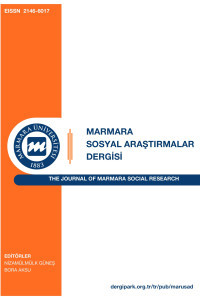YENİ KURUMSAL MANTIKLARIN DOĞRUŞUNDA GİRİŞİMCİLİK ETKİSİ: STEVE JOBS'IN GÖRÜŞMESİNE İLİŞKİN BİR VAKA ÇALIŞMASI
Kurumsal değişim sürecinde girişimcilik etkisi, yaygın olarak kabul görmektedir. Kurumsal mantık yazını, kurumsal girişimcilik kavramı ve proto-kurum perspektiflerinin tümü, girişimcilerin kurumsal çevre üzerinde nasıl bir etkiye sahip olabileceğine dair açıklamalara sahiptir. Örgütlerin incelenmesinde tarihselci yaklaşımların önem kazanması ile (özellikle son zamanlarda kolektif bellek çalışmalarına ilgi başladıktan sonra) öz oluşum kavramı, değişim mekanizmalarını açıklamada önem kazanmıştır. Öz oluşum tanımı örgütsel çalışmalarda yaygın olarak kullanılmasına rağmen kavramsal olarak karmaşık yapısı genellikle göz ardı edilmektedir. Bu çalışma, kurumsal mantığın öz oluşum ile açıklanabilen bir fenomen olduğu, dolayısıyla bir sosyal çevre içindeki karmaşık etkileşimlerin değişimi ile tetiklendiği ve girişimcilere istenmeyen sonuçlar olsa bile yeni mantıkları kurumsallaştırma şansı verdiği fikrini paylaşmaktadır. “Steve Jobs'un Kayıp Röportajı” örnek vaka olarak, etkileşimleri aydınlatmak ve yeni kurumsal mantıkların ortaya çıkışının birleşik bir modelini önermek için seçilmiştir.
Anahtar Kelimeler:
Girişimcilik, Kurumsal Değişim, Kurumsal Mantık, Steve Jobs, Öz Oluşum
ENTREPRENEURSHIP EFFECT ON EMERGENCE OF NEW INSTITUTIONAL LOGICS: A CASE STUDY OF STEVE JOBS’ INTERVIEW
The effects of entrepreneurship are widely recognized in the process of institutional change. The institutional logics literature, institutional entrepreneurship concept and proto-institutions perspectives all have explanations about how entrepreneurs can have an effect on the institutional environment. After history become important in studying organizations – especially after the recent interest for collective memory has begun – the concept of emergence have gained importance on explaining the mechanisms of change. Although the concept of emergence is widely used in the organizational studies its definition and complex nature is commonly ignored. This study however share the notion that institutional logics are an emergent phenomenon thus complex interactions inside a social environment triggers change and gives chance to the entrepreneurs to institutionalize new logics even if they are unintended consequences. The case of “The Lost Interview of Steve Jobs” has been chosen to enlighten the interactions and to propose a unified model of the emergence of new institutional logics.
Keywords:
Emergence, Entrepreneurship, Institutional Change, Institutional Logics, Steve Jobs,
___
- Battilana, J. (2006). Agency and institutions: the enabling role of individuals’ social position. Organization, 13(5) 653-676.
- Boxenbaum, E. (2004). The Emergence of a proto-Institution. http://hdl.handle.net/10398/6726 Date of Access: 01.09.2016
- Czarniawska, B. (2009). Emerging Institutions: Pyramids or Anthills? Organization Studies 30( 4) pp. 423 - 441
- Dimaggio, P. J., & Powell, W. W. (1983). The iron cage revisited: Institutional isomorphism and collective rationality in organizational fields. American Sociological Review, 48(2), 147-60.
- Fagerberg, Jan. (2003). “Schumpeter and the revival of evolutionary economics: An appraisal of the literature.” Journal of Evolutionary Economics 13:125-159
- Friedland, Roger and Robert R. Alford. (1991). “Bringing Society Back In: Symbols, Practices, and Institutional Contradictions,” pp. 232-63 in Walter W. Powell and Paul J. DiMaggio, eds. The New Institutionalism in Organizational Analysis. Chicago: University of Chicago Press.
- Garud, R. and Karnøe, P. (2001) ‘Path creation as a process of mindful deviation’. In Path dependence and creation, R. Garud and P. Karnøe (eds.) Lawrence Earlbaum Associates: 1-38.
- Hwang, H. & Powell, W. W., (2005) “Institutions and Entrepreneurship.” pp:179-210; Sharon A. Alvarez, Rajshree Agarwal, Olav Sorenson edt. International Handbook Series on Entrepreneurship Vol. 2.
- Jones, G. (2013). Organizational Design and Change. Pearson
- Lawrence, T.B., Hardy, C., & Phillips, N. (2002). Institutional effects of interorganizational collaboration: the emergence of proto-institutions. Academy of Management Journal, 45(1): 281-291.
- Lippmann, S., Aldrich, H.E. (2016), A Rolling Stone Gathers Momentum: Generational Units, Collective Memory, And Entrepreneurship Academy of Management Review 41(4), 658–675.
- Ocasio, W., Mauskapf, M.; Steele, C. W. J. (2016), History, Society, And Institutions: The Role Of Collective Memory In The Emergence And Evolution Of Societal Logics. Academy of Management Review 41(4) 676–699
- Özgen, E. & Baron, R. A. (2007). Social sources of information in opportunity recognition: Effects of mentors, industry networks, and professional forums. Journal of Business Venturing. 22(2), 174–192
- Powell, W. W., White, D. R., Koput, K. W., & Owen-Smith, J. (2005). Network dynamics and field evolution: The growth of interorganizational collaboration in the life sciences. American Journal of Sociology, 110(4), 1132-1205.
- Schumpeter, J. (1934). Theory of Economic Development. New York: Oxford University Press.
- Schumpeter, J. [1946] (1991). “Comments on a Plan for the Study of Entrepreneurship.” Pp. 406-28 in The Economics and Sociology of Capitalism. Princeton: Princeton University Press.
- Scott, W. R. (1994). Conceptualizing organizational fields: Linking organizations and societal systems. In H. Derlien, U. Gerhardt, & F. Scharpf (Eds.). Systems rationality and parcial interests (pp. 203-221). Baden: Nomos.
- Scott, R. W. (2003). Institutional carriers: reviewing modes of transporting ideas over time and space and considering their consequences. Industrial and Corporate Change, 12(4): 879-894.
- Strang, David, and John W. Meyer. (1993). “Institutional Conditions for Diffusion.” Theory and Society 22: 487-511.
- Swedberg, Richard (Ed.). (2000). Entrepreneurship: The Social Science View. Oxford: Oxford University Press.
- Thornton, P. and Ocasio, W. (1999). Institutional Logics and the Historical Contingency of Power in Organizations: Executive Succession in the Higher Education Publishing Industry, 1958–1990. American Journal of Sociology 105 (3): 801–843
- White, D. R., Owen-Smith, J., Moody, J., & Powell, W. W. (2004). Networks, fields and organizations: Micro-dynamics, scale and cohesive embeddings. Computational & Mathematical Organization Theory, 10(1), 95-117.
- Yayın Aralığı: Yılda 2 Sayı
- Başlangıç: 2011
- Yayıncı: Marmara Üniversitesi
Sayıdaki Diğer Makaleler
TURİZM VE SEYAHAT FAALİYETLERİNİN DÜNYAMIZDA BIRAKTIĞI KARBON AYAK İZİ TAKİBİ VE KONTROLÜ
SANATTA ETKİLEŞİM: Türk-İran Örneği
KAYNAŞTIRMA UYGULAMALARINI BAŞARIYA ULAŞTIRAN ETMENLER
İŞLETMELERDE YAŞANAN MUHASEBE SKANDALLARININ ÖNLENMESİNDE ALINAN DENETİM TEDBİRLERİ
ENDÜSTRİ 4.0-TÜRKİYE'NİN DURUMU VE YAPILMASI GEREKENLER
SOSYAL KAYTARMA DAVRANIŞINA KAYNAKLARI KORUMA TEORİSİ YAKLAŞIMI
